From July 2nd to 9th, 2025, I joined the mission, ‘Ukraine Reconstruction Support Mission, ’organized by Japan’s Ministry of Economy, Trade and Industry (METI), Ministry of Foreign Affairs (MOFA), and JETRO. This report highlights COGNANO’s contribution to this war-affected country during the mission. Due to security concerns, I was unable to provide updates while I was in Ukraine. Now that the mission is successfully completed, I’m pleased to share the report.
Although this mission team was officially referred to as an ‘observation convoy,’ its role extended well beyond mere observation, functioning more like a ‘networking brigade.’ Through hands-on experiences of the nation’s realities, it aimed to explore the ways in which Japan, both in official and private sectors, could contribute to Ukraine’s recovery efforts.
In this blog, I share my experiences and gut feelings from my time in Ukraine. (For security reasons, I apologize for not clarifying some names and locations.) I aim to restrain from making ethical judgements on war and politics, as I believe drawing a clear line between right and wrong is futile, given the limited scope of my knowledge.
This is an official blog from COGNANO that explains why this small, Far East-based player in drug discovery feels driven to collaborate with Ukraine.
Preparations in the U.S., U.K. and Western Europe
- The mission, originally scheduled for June, was postponed to early July due to escalating military conflict between Ukraine and Russia.
- At ICLR 2025 in Singapore, one of the premier AI conferences, we engaged with Ukrainian IT engineers to discuss forming a collaborative business structure. While our primary focus was on COGNANO’s biotech platform, we emphasized to each one of the engineers that this initiative would also serve as a project to support Ukraine.
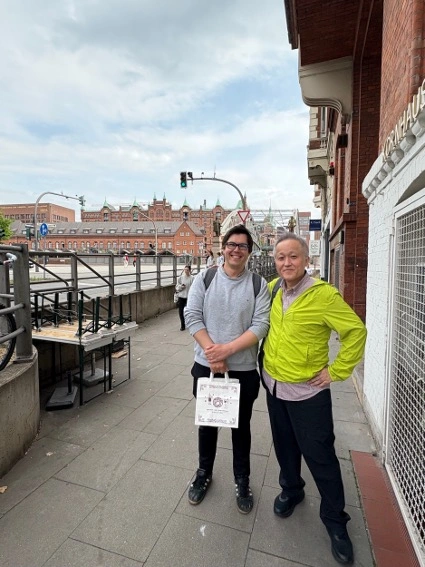
- At Caltech in the U.S., we met with IT researchers to discuss planning for an AI drug discovery competition organized by COGNANO.
- We were invited to the home of a medical mentor in Boston. His parents, of Polish descent from Kyiv, included a father, who was a chemist and businessman, and his mother. This medical doyen shared the hardships his family faced when fleeing from Ukraine to settle in the U.S. at the beginning of World War II. Tough he wished he’d been able to visit Ukraine, he expressed great willingness to support our efforts from Boston and was keen to share updates from his homeland.
- In Germany, I met Konrad Krawczyk, CEO of the Polish AI discovery firm NaturalAntibody, and finalized a business partnership.Save time in creating and collating antibody-specific datasets. Benefit from ready-made data collection pipelines that have fresh and regularly updated datasets. Search for antibodies by sequence, text, or sequence, and get all the search results in one place. Compare parameters and find shared attributes across different databases.
https://www.naturalantibody.com/
Team Assembly in Warsaw
July 2: I attended a Japan-Korea-Poland business forum in Warsaw. Unfortunately, I caught a cold and ran a fever, but I managed it with the medicine I’d packed. In the evening, our observation team, which included leaders from JETRO, METI and MOFA staff, along with delegates from private sectors, gathered for the first time.
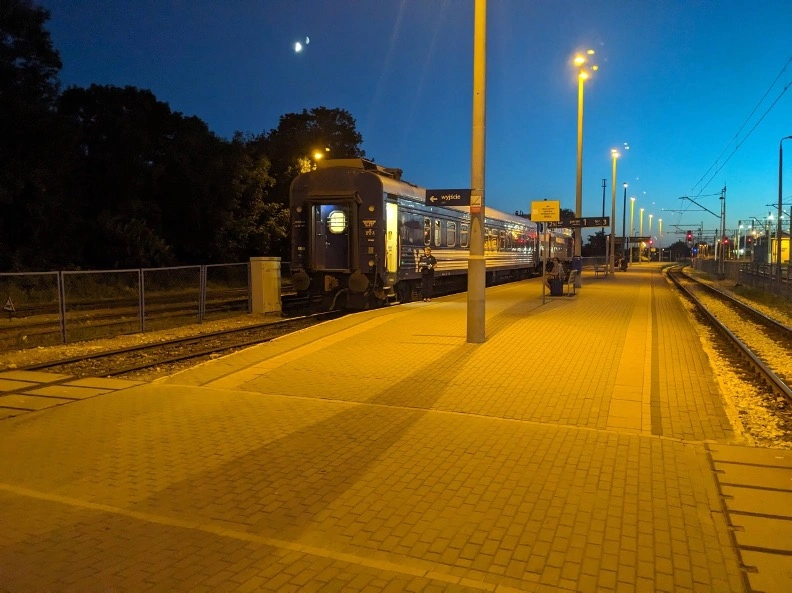
The team departed for Ukraine in a chartered bus where it was provided with battlefield first-aid kits along with instructions to use them. At 10 p.m., we boarded a Ukrainian sleeper train in Chelm near the Poland-Ukraine border. I downloaded the Air-Alert app to monitor sirens.
In Kyiv
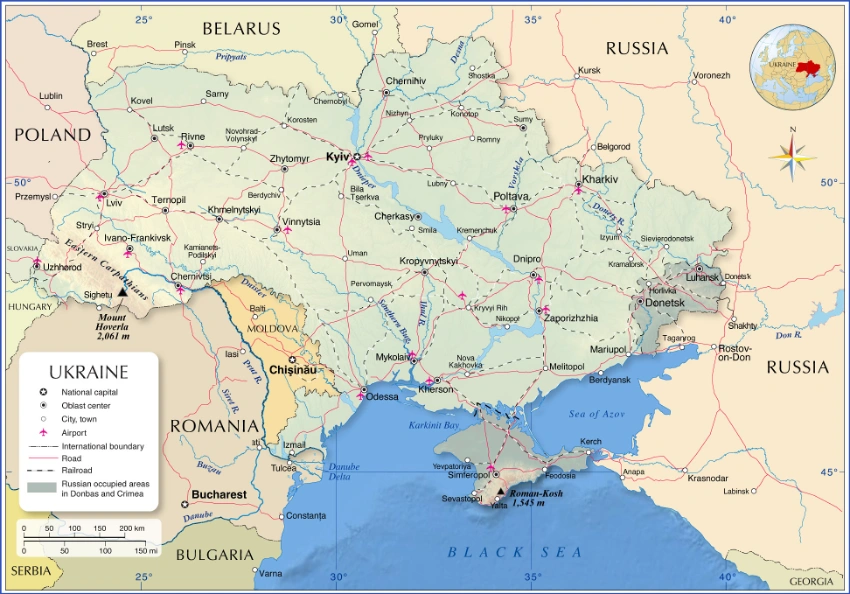
July 3: We arrived in Kyiv early in the morning, greeted by the sight of an old but imposing station building. From there, we traveled to a downtown hotel in several safeguard cars. After checking in, we changed into formal suits and visited the government office to meet with First Deputy Prime Minister Yulia Svyrydenko. I mentioned to her that I was a great fan of the Ukrainian National Ballet, all the way from the other end of the world, though later I questioned to myself whether such a comment was suitable for a diplomatic occasion. Following this, we visited St. Michael’s Monastery to offer silent prayers for the war victims enshrined there.
That evening, we attended a public-private exchange party hosted by the Kyiv Chamber of Commerce. As the party was about to conclude, an air raid siren sounded, forcing us into an underground shelter – a fitting treatment by Moscow at Day 1 in Kyiv. We remained underground overnight.
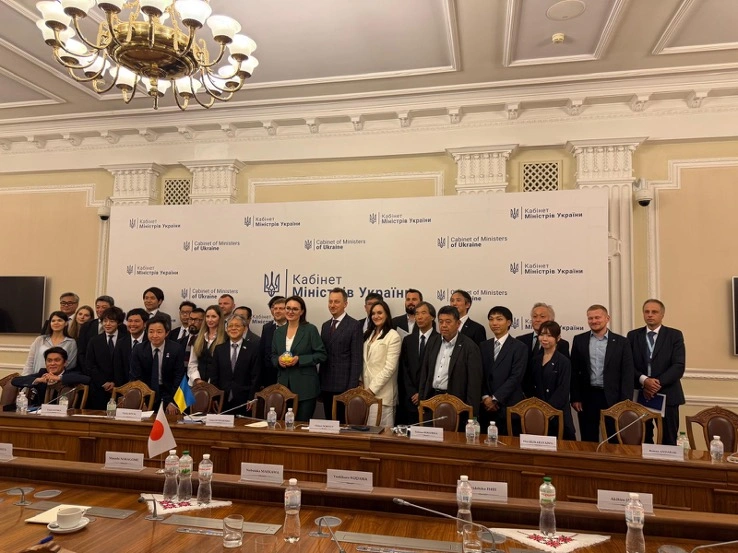

July 4: We visited an industrial cluster and participated in business pitch meetings. During a Japan-Ukraine industry matching event, I reconnected with representatives from the global CRO PVR and successfully secured a business partnership - a significant accomplishment.
Later, as we strolled around Maidan Square, another air raid warning echoed through the streets, prompting our evacuation to a Soviet-era metro station 100 meters below ground. As Russian Mig fighter jets appeared on the radar, a nationwide air alert was issued due to uncertainty of their target.
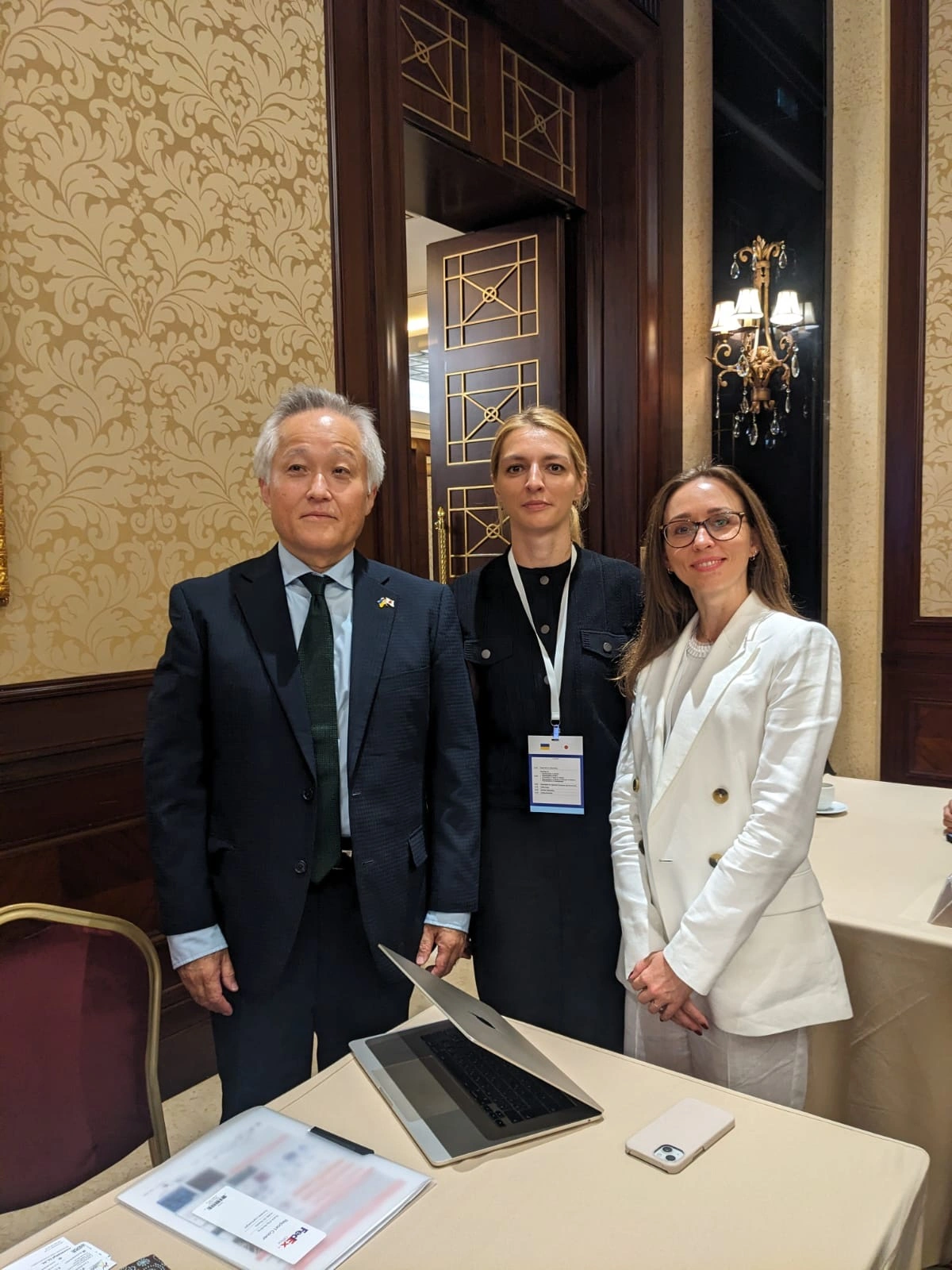
We moved to an underground bar for a drink as if nothing had happened. At the bar a military-affiliated folk ensemble called Cultural Forces greeted us by playing the violin and the bandura, a traditional Ukrainian instrument. The violinist, a wounded female soldier, left a deep impression on me. I was told she was still in service, and fighting on the front line on a daily basis. ‘Even after enduring an all-night air raid, we Ukrainians would take it in stride and show up for work in suits next morning. Isn’t that cool,’ said one of the staff from PVR. She was truly a nice and high-spirited woman.
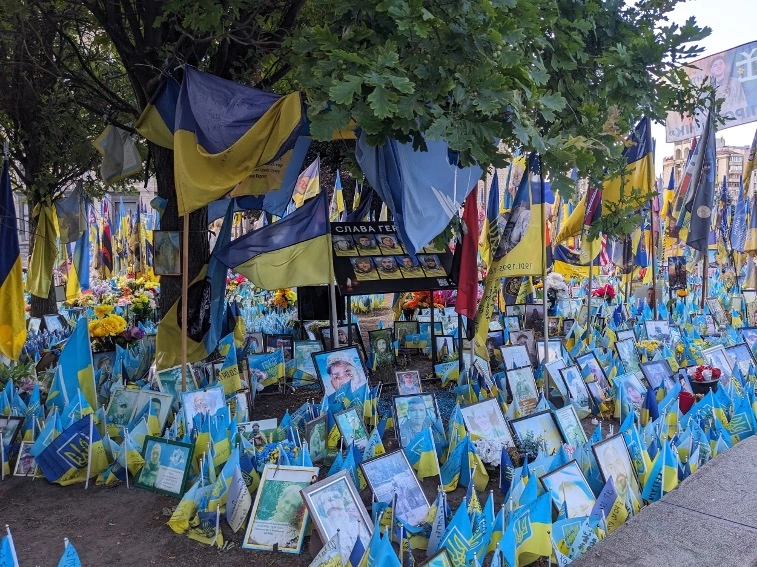
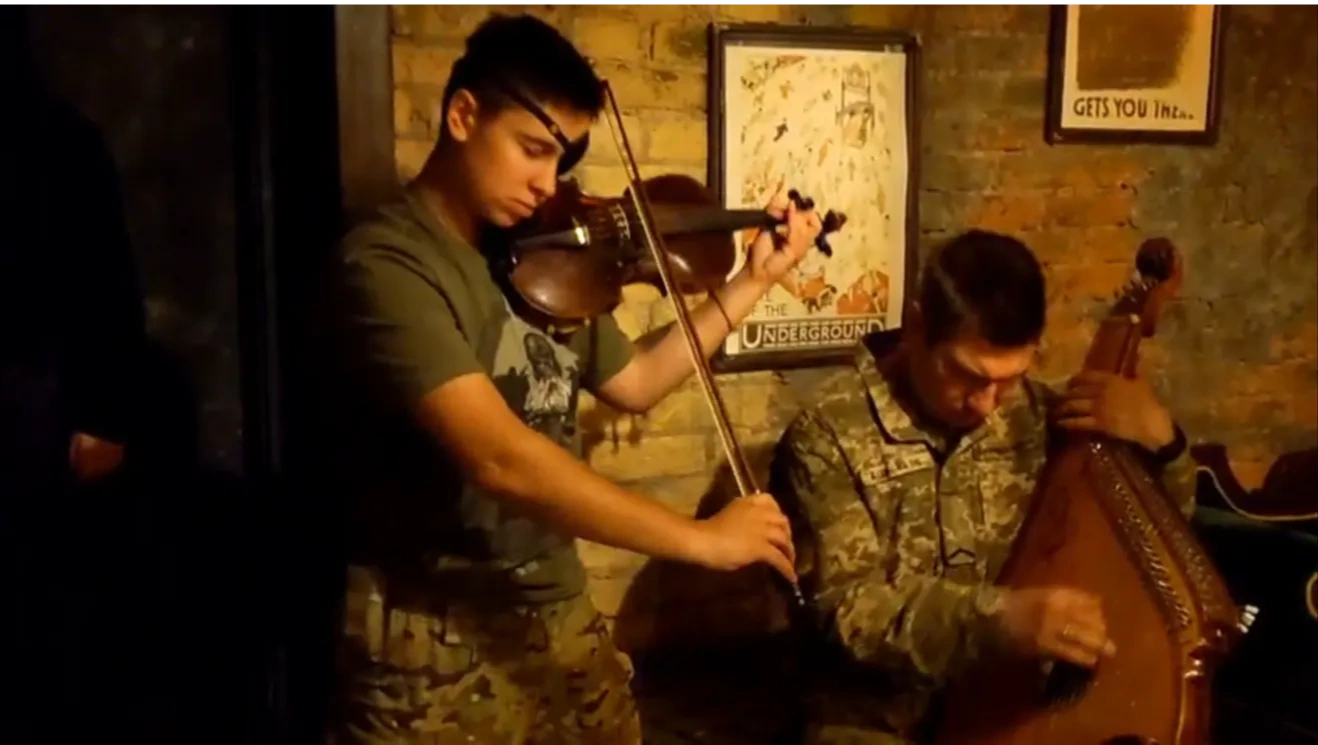
The moment I returned to the hotel and began to feel some relief, the blaring of another air raid siren shattered the calm. Reports flooded in that numerous military drones were attacking different regions across the country. Watching news on TV felt somewhat surreal, as if I were looking at video game graphics rather than real events. It seemed as though the concept of war itself had transformed. Following the local custom of drinking strong alcohol, I spent the entire night in an underground shelter, half-drunk.
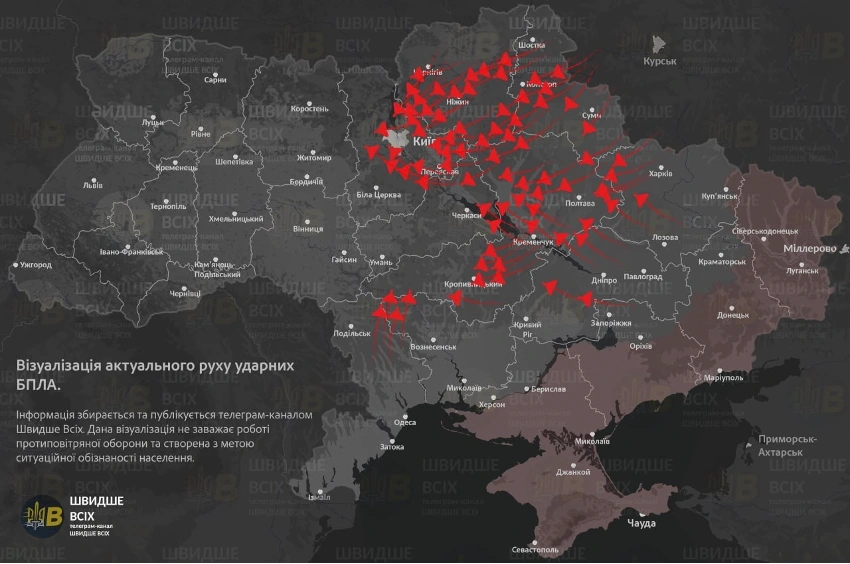
July 5: Still groggy from a lack of good sleep, we visited factories and business district in town. Among our stops, we were led to a building devastated by a ballistic missile. The powerful explosion wreaked havoc on the surrounding areas.
That evening, our team boarded a sleeper train bound for Lviv, leaving Kyiv behind. Throughout the journey, air raid alerts blared incessantly, keeping me on edge as I wondered whether railways might be a target. Despite the tension, I found a relief in knowing I was recovering from my cold.

In Lviv
July 6: We arrived in Lviv early in the morning. After checking into the hotel, we began our visit with a massive war cemetery. I was deeply moved by the vast number of graves stretched across the recently developed site. Many families of war victims were quietly offering prayers to their loved ones, with their candles casting a somber glow. The city of Lviv exuded a strong sense of independence, with a distinctly Catholic atmosphere compared to the Orthodox influence of other regions. The city felt distant from Kyiv, both physically and spiritually.
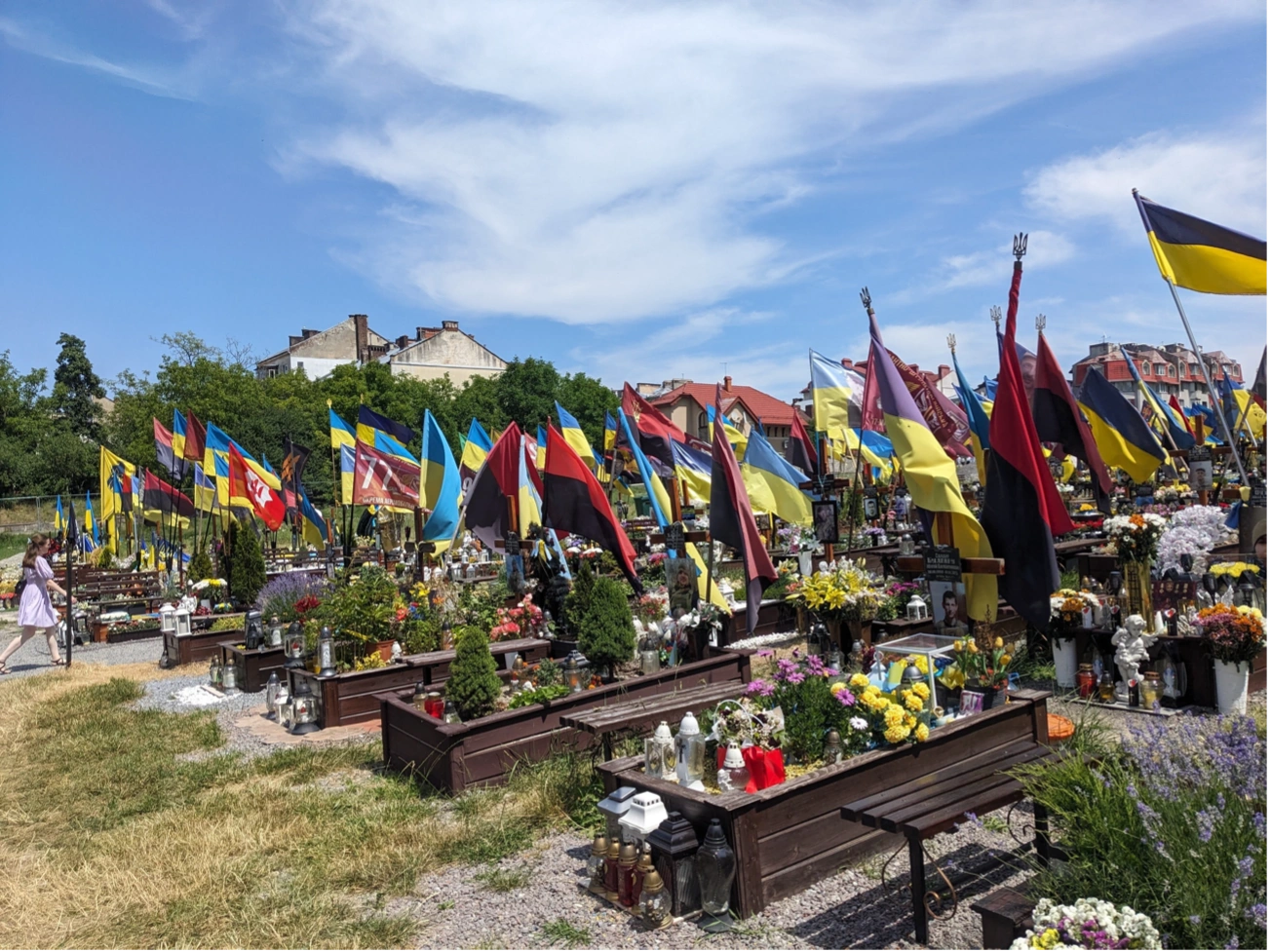
We then explored the old district of the city. With far fewer air raid alarms, we anticipated a good night’s sleep. However, the lingering impression of the cemetery haunted me, making it hard to drift into restful sleep.
July 7: At 9 a.m., we gathered at City Hall to offer prayers to war victims, joined by the mayor of Lviv. Following this, we attended a ceremony to inaugurate JETRO Japan Desk, with the mayor and former JETRO chairman Maekawa also present. I delivered a business presentation at a forum attended by members of the Lviv industrial circle.

In the afternoon, we paid a visit to the rehabilitation center, UNBROKEN, which houses many individuals wounded by the war. The trainees, equipped with prosthetic limbs, gave their all in rigorous rehabilitation and training, showcasing remarkable resilience and high morale. It was as though they were resolutely denying their physical limitations and devastation caused by the war.
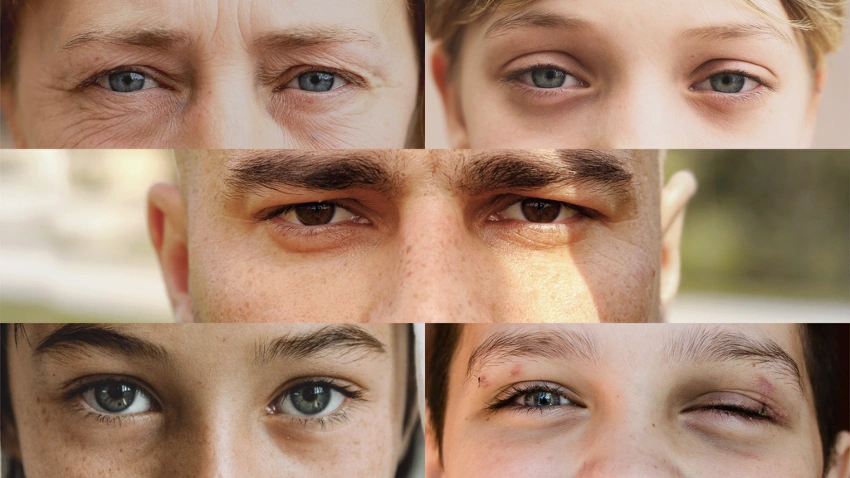
In a way, these individuals might be considered fortunate – they wouldn’t be there if they had been fatally injured in the head or the torso. Meanwhile, craftsmen at the neighboring prosthetic device manufacturing plant were working tirelessly at their full capacity. Those suffering from war-induced PTSD were also working hard to reintegrate into social life. I then recalled that the violinist from Cultural Forces, who performed in Kyiv, had a single eye. To my surprise, those wounded individuals appeared even radiant, showing no signs of war misery.
In the evening, I attended a business matching event at a stylish resort center repurposed from an old jam factory. With fewer air raids, Lviv game me an impression of a city thriving in business while preserving the tranquil charm of a traditional European town.
July 8: I visited biotech firms in the morning, followed by a discussion with Lviv IT cluster in the afternoon regarding the hiring IT-related human resources. During my stay, I recognized the strategic military implications of IT in Ukraine.
During our final mission in Lviv, the entire observation team was invited to tour a Japan-based manufacturing factory, where we were treated to a delightful lunch in a vary cozy atmosphere. Wherever we visited in Ukraine, we were always served an exceptional meal. – it felt as though we were receiving support rather than providing it. Anyway, we were pleased and appreciated the opportunity to enjoy these feasts.
Afterward, we boarded a train back to Poland. When we crossed the national border, an air raid siren sounded, almost like a poignant farewell. Though our stay in Ukraine lasted only a week, I’d never felt so reluctant to leave a foreign country in my life. Shortly after midnight, we arrived at a Polish town near the border, headed straight to a hotel.
In Rome
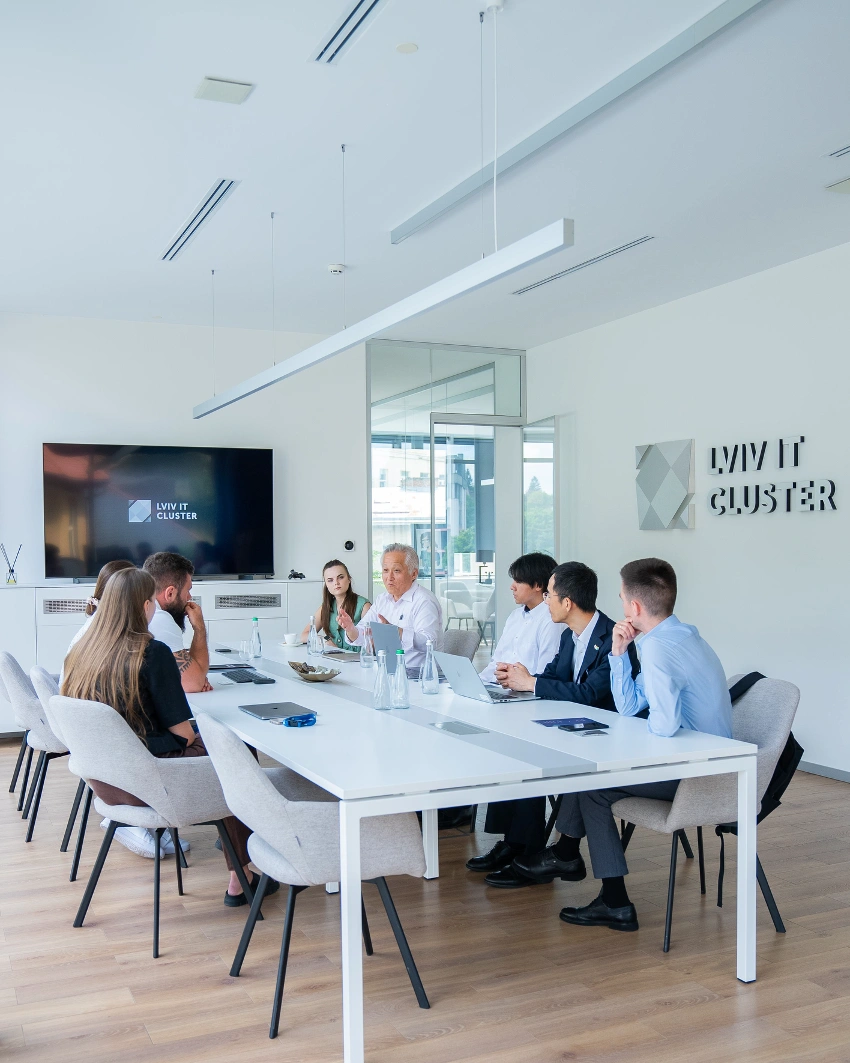
July 9: We woke up at 3 a.m. to catch a flight to Rome, where were to attend the third Ukraine-Japan Reconstruction Conference. The flight arrived at 10 a.m. on schedule, but we faced delays at the airport for two hours due to missing baggage. Feeling exhausted and sleepy - likely a result of being relieved from the constant tension of staying alert to air raids - I managed to take a one-hour nap after checking into the hotel.
At the Japan-Ukraine roundtable hosted by JETRO, I delivered a brief yet passionate presentation, emphasizing collaboration with COGNANO. Thirty-nine-year-old bright lady, First Deputy Prime Minister Svyrdenko, was the keynote speaker. She was set to be appointed by Ukrainian President Volomydyr Zelenskyy as Prime Minister the following day.
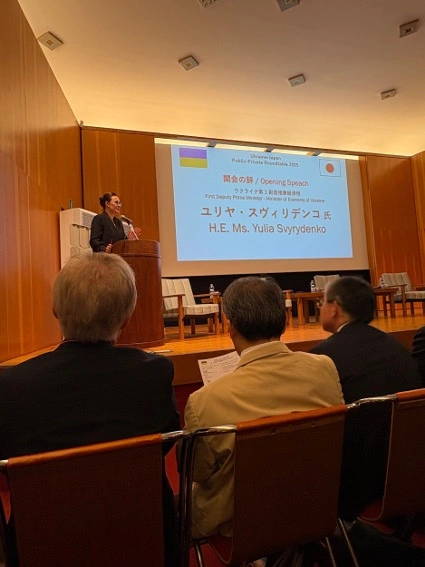
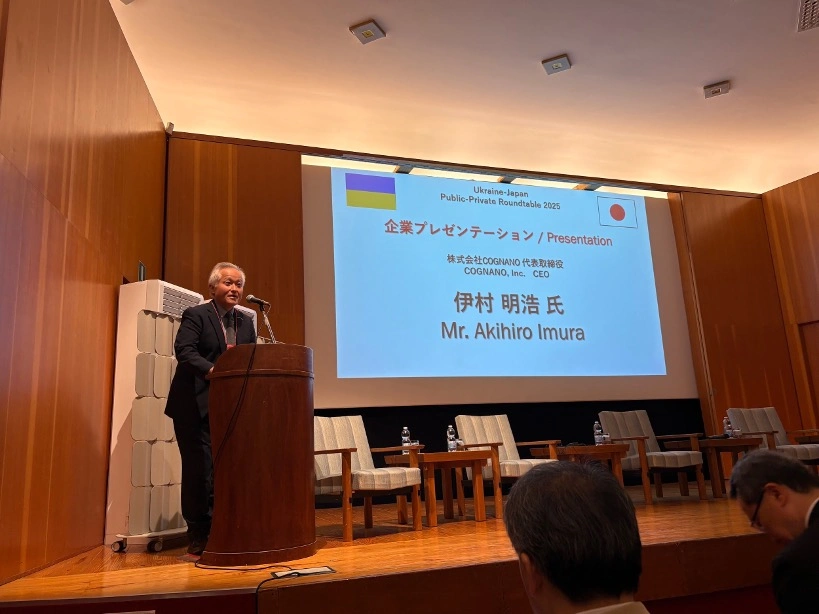
Disbandment
With our mission complete, our team disbanded. I missed everyone deeply, despite all of us meeting for the first time. Over our only one-week time together, we had built a strong sense of camaraderie.
Before returning to Japan, however, I had one last task to accomplish.
In Graz, Austria: Visiting UAB BioBank Team
We aim to validate our AI predictions using a diverse range of bio samples, including those from cancers and degenerative diseases. These bio samples are typically stored at individual hospitals and medical institutions, requiring complex and customized procedures to gain access. In this context, Ukraine’s centralized biobank, UAB, which houses bio samples from across the country (perhaps those dating back to Soviet era), aligns perfectly with our objectives.
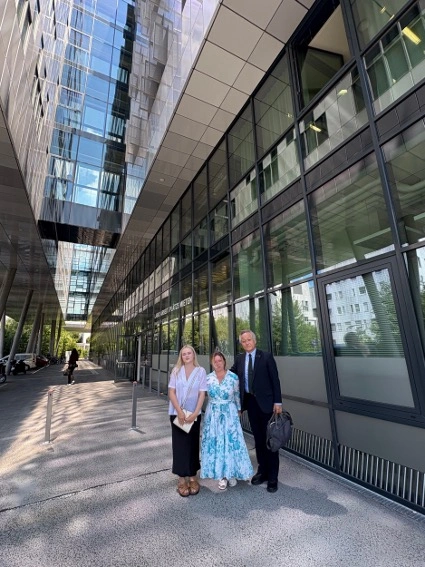
UAB was originally based in Kharkiv, which came under intensive attacks by Russia in 2022. Professor Svetlana, head of UAB, along with her staff went to extraordinary lengths to relocate valuable bio samples. They personally drove trucks nearly 2000 km from Kharkiv to Graz, Austria. When I met Prof. Svetlana, she shared the hardships and challenges she and her team had endured over the last three years since relocation to temporary institution at Graz Medical School. I promised to contribute, in whatever small ways COGNANO could do, to her research, particularly in pediatric oncology.
During our conversation, it began to rain heavily. Prof. Svetlana and her secretary Marie burst into delight, clapping their hands, exclaiming, ’A sudden rain during a meeting is a sign of a promising outcome!’
I took a train back to Vienna. I was too exhausted for any sightseeing in this historic capital city. After grabbing a quick bite of curry from a food stand at the train station, I collapsed into a deep sleep at the hotel.
When I woke up, I was bewildered by the sight of bustling vacationers on the streets, seemingly unaffected by even the slightest threat of an air raid. What a shift! I realized that my mission was all over.
Final Reflections
- I spent two consecutive nights in an underground shelter in Kyiv, located three stories deep. However, the lack of any explosion sounds from landing missiles made me surprisingly calm.
- There were few soldiers or military personnel, or no tanks or anti-air bases in the urban areas.
- Civilians demonstrated remarkable resilience, enduring air raids at night and commuting to work every morning as if nothing had happened.
- People were in the habit of offering silent prayers to the war dead every day at 9 a.m.
- Public security was well maintained in cities even amid the war; there were no groups such as vigilantes or military police.
- Despite experiencing the most intense airstrike on Kyiv during our stay, there was no disruption to electricity or water supply. Wi-Fi, including Starlink, remained in good condition across the nation.
- There were numerous graves for the war dead, adorned with flowers that had been donated. Among those honored were many female soldiers and young individuals.
- Cities of Kyiv and Lviv, both centuries-old town, were well maintained, with clean parks and streets.
- Homeless people, who are common in most major European cities, were almost nonexistent in Ukrainian cities.
- There was no overt campaigns or hostile slogans against Russia, apart from humorous souvenir items like toilet paper featuring Putin’s face. The Ukrainian people seem to distinguish between the Russian state, governed by Moscow regime, and its citizens.
- I saw many young men on the streets who had lost their limbs, and yet they appeared spirited and full of energy.
- There was an ample supply of food and essentials, with supermarkets and retail stores well-stocked. The citizens showed no signs of frugality.
- Even during air alerts, weddings and matchmaking events among young people continued to take place.
- Ukrainian men and women enjoy drinking, but rarely cause trouble. I did not come across any drunken individuals who were involved in fistfights or shouting matches.
- Most young people in the urban areas are proficient in English.
- The Byzantine-style hymn sung at St. Michael’s Monastery in Kyiv was profoundly moving. I noticed a young woman in prayer, silently shedding tears.
- What will become of Prof. Stevlana’s institution in Vienna, which safeguards bio samples that have been collected by Ukraine over many years?
- It’s noteworthy how the Ukrainian people express gratitude to Japan’s outreach programs implemented by MOFA representatives, government officials and JETRO staff.
Why COGNANO goes to Ukraine
Let me reiterate why COGNANO must go to Ukraine and the purpose behind it.
COGNANO has undergone a rigorous selection process and had the honor of presentation three times in the past two year at prestigious AI conferences, including NeurIPS and ICLR – an exceptional achievement for a biotech organization. This significant milestone reflects the relentless dedication of our IT researchers and machine learning specialists. This is made possible by our extensive database, which sheds a new light on antigen-antibody relationship. My wild guess suggests that our body contains approximately a billion sets of molecular structures to be clarified for drug discovery. This process is estimated to require a vast pool of antibodies, with more than a few dozen billion repertoires serving as a probe. The advantage of using antibodies as probes lies in their unique ability to recognize its counterpart antigen on a strictly one-on-one specificity, regardless of the number of counterparts present. Additionally, alpaca antibody, or VHH antibody (nanobody), consists of a single amino acid chain. This simple structure makes them easily translatable into digitalized data based on a sequence of 20 amino acids. Antibody data from more than a billion clones seem overwhelming from the perspective of traditional bio-industries. However, from data-science standpoint, it is entirely manageable. COGNANO is currently estimated to have accumulated nearly 90 percent of the world’s digital data, and we are actively expanding our capacity for data generation. I encourage you to explore our previous blogs to gain insight into how extensive dataset can pave the way for entirely automated drug discovery. The objective of our mission to Ukraine is to recruit IT specialists from the region to help establish algorithmic framework required for realizing automated drug discovery using our vast dataset.
Following the collapse of the Soviet Union, many Ukrainian students, particularly after the year 2000, pursued careers as IT engineers in their quest for economic independence. As a result, Ukraine has become a hub for outstanding IT talent, with numerous Ukrainians recognized as leaders in the world’s major tech companies. It is clear that the success of military drone campaign relies significantly on IT engineers, rather than on manufacturers of the machines. IT truly thrives when it is aligned with a specific business target. From online meeting, map creation, booking hotels and restaurants, to accounting, investing, banking and entertainment – virtually any business needs can become IT service as long as it can be digitalized. Despite its critical area for humanity, however, medicine has yet to fully become a target of IT services. Why? Because an adequate volume of biological data has not yet been digitalized. Cancer and dementia remain largely beyond our control for now, primarily due to the lack of foundational data on biological molecules and cellular information. While the genome provides an accessible entry point for informatization, its data alone are insufficient to address human diseases. COGNANO has achieved a breakthrough by creating a massive volume of digitalized biological data. (As you know, alpaca plays a crucial role in accomplishing this feat!) With a help of AI, our next goal is to determine the specific molecular structures that antibodies recognize as probes to detect molecules and cellular features unique to a given disease. Once identified, a computer could instantly reveal the structure of a target molecule.
Together with young, patriotic Ukrainian engineers, we will continue establishing an algorithmic framework for automated drug discovery – a crucial step toward our growing into a global pharmaceutical company that can support disease-affected populations worldwide. This initiative also represents a strategic opportunity for Ukraine to enhance its global presence by contributing to an industry driven by goodwill. We’re proposing a scheme in which the Ukrainian government, Ukrainian engineers in evacuation and COGNANO collaborate to develop technology for automated drug discovery.
Had it not been for World War II, the medical mentor’s family in Boston might never have immigrated from Ukraine to the U.S. Similarly, without the current Ukraine-Russia conflict, COGNANO might not have had an opportunity to accept many talented Ukrainian engineers. Every situation has its dual aspects – a war brings immense tragedy, yet it also gives rise to new possibilities. At least, that’s what I hope. I’m fully committed to tackling new challenges arising from the present conflict.
My heartfelt thanks go to COGNANO members who have taken my responsibilities during my extended absence. A warm welcome to the newcomers from Ukraine! I also deeply appreciate the dedicated efforts by JETRO staff, as well as MOFA and METI officials, for ensuring a successful mission. Kudos as well to the exceptional work by other private sectors from Japan!
This is edited by Dr. Kimio Fujii for english.